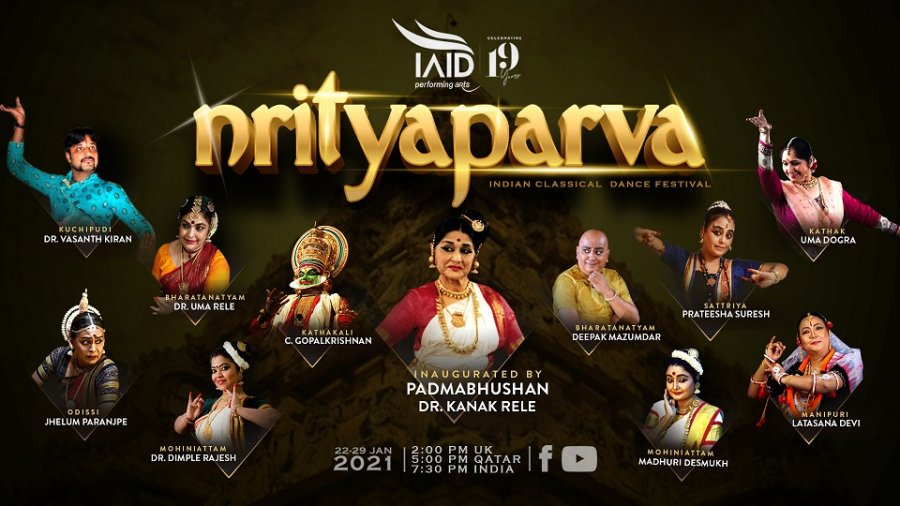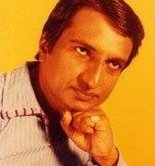
|   |

|   |
Nrityaparva - Festival of eight classical dance styles - Vijay Shanker e-mail: vijaydance@gmail.com March 19, 2021 Nrityaparva - festival of eight distinct classical dance styles - was organized from January 22 to 29, 2021 virtually for the first time by leading socio-cultural organization from Doha, Qatar, by International Academy for Intercultural Development (IAID). IAID is Qatar's premier and biggest performing arts academy, offering courses in dance, music and arts since 2001. Founded by Dr. Dimple Nair and Rajesh, the academy has organized several national and international events over the years featuring Indian, Asian and western art forms that included a film festival too. The inaugural performance was by Mohiniattam exponent and dance educationist, Dr Kanak Rele. "Normally youngsters migrate to Gulf countries for employment and I am really happy to note that my senior disciple Dimple has established her own cultural organization and is promoting Indian classical dances in a big way, hence keeping the Indian flag flying high. In spite of living far away from India, I am glad she is maintaining her cultural grounds and values." Welcoming everyone to the festival, Dimple Nair said, "The pandemic has made all of us miserable but it is only through the performing arts, we can rejuvenate and reinvent ourselves." The festival commenced with the Mohiniattam performance by Dr. Dimple Nair Rajesh and Dr. Madhuri Deshmukh, senior-most disciples of Dr. Kanak Rele. After the beautiful invocatory Ganapatiye, the next number was Kubja, the thematic choreography by Dr. Kanak Rele. Kubja was originally written by Odiya poet Sitakanta Mohapatra, and translated into Malayalam by Kavalam Narayana Panikkar. The typical hunch of Kubja symbolizes the pain and suffering women have experienced over the centuries and in this number the dancer depicts Kubja as the servant of the wicked king Kamsa and how she attains her original form and beauty due to her devotion for Lord Krishna forming the crux of the performance. Commendable abhinaya and soulful singing by Gireeshan were the highlight of this presentation. Based on temple rituals and the Srichakra pertaining to tantra and mantra, the geometrical movements and brilliant choreography by Dr. Kanak Rele, signified the importance of the number 'Tatvam.' Yet another women centric piece 'Amba' portrayed how women fought against varied trials and tribulations and emerged successful. The story of how Amba was cheated by both Shalva and Bhishma and how she was born again as Shikandi to take revenge was enacted with emotional intensity by Dimple. The duo concluded the performance with Jeeva, the union of the human soul with the divine. The Bharatanatyam performance commenced with a beautiful interpretation of Shankaracharya's Namah Shivaya by Vaidehi Rele, describing the varied attributes and features of the Lord. It was a lively dance with vibrancy and grace. Swati Tirunal's Krishna bhajan was performed by Dr. Uma Rele with devotional fervor. The story of the outcaste Nandanar, an ardent devotee of Lord Shiva, who is denied entry to the temple but ultimately gets the darshan was enacted with complete dexterity by Guru Deepak Mazumdar. Kathakali performance incorporated the story of Rukmini Swayamvaram. Rukmini wants to marry Krishna but her brother wants her to marry Shishupal. The Brahmana advises Krishna to fetch Rukmini from Vidarbha and how Krishna manages to marry Rukmini forms the core of the presentation. Renjish Nair as Krishna and Kalamandalam Gopalakrishnan as Brahmana impressed with commendable abhinaya and involvement. Renjish was noteworthy for the serene and pleasing expressions on his face. Both performers created a favorable impression.  Unlike the normal Odissi recitals with traditional numbers, Jhelum Paranjape went a step further with her choreography wherein Draupadi questions, pleads and then gets angry with her five husbands for having lost her in the game of dice and questions Krishna too. Why did you not stop them from playing the game of dice? The plight, the suffering and the typical angika abhinaya of the dancer was well established, particularly in the Marathi abhang describing the low caste devotee of Lord Vitthal, who is beaten by the people as he tries to enter the temple. The musical rendering and percussion music used to dramatize the pain and suffering of the devotee, was the highlight of the piece. "Baso mere naini mei Nandalal" (Stay in my eyes, my Nandalal) refers to Lord Krishna. Beautiful interpretation of vatsalya bhava establishing the relation between Krishna and mother Yashoda, was the starting number of the Kathak recital by Uma Dogra and her talented senior disciples Indrayanee Mukherjee and Sarita Kalele. The first number was performed well by Indrayanee who is blessed with a pleasing personality and a serene expression on her face, that suited the character represented. Sarita Kalele is another charming dancer with a vivacious quality and attractive smile. Sarita impressed the audience with pure dance sequences like 15 Matra Pancham Sawari, Utthan, Thaat, Amad, Paramelu, tatkaar and tihai that was executed with precision. How wicked and vicious a woman can be, was displayed by Uma Dogra in the characterization of Manthara. The Kuchipudi performance by Dr. Vasant Kiran from Bangalore and his talented disciples, created a magical spell on the viewers. Commencing with Pillari Geeta Ganapati "Lambodara" made a fine start to the performance, noteworthy for its precise, rhythmic and stylized movements, along with few akash charis performed by Vasant Kiran. Brahma Anjali interspersed with Sanskrit shlokas, highlighting the typical Vempati style of Kuchipudi was performed by Deepika Krishna from Bangalore. Ganesh Kautvam was performed by Meera Nair (USA) and the Kuchipudi goddess Kuchipudi Talliki was presented well by Kavya Sriniwas (Anantapur) that was followed by Bhama Kalapam. An interesting Purandara Dasa composition on child Krishna and mother Yashoda was performed with subtle abhinaya by Vasant Kiran. The Manipuri performance was rendered by Latasana Devi and Purbita Mukherjee, commencing with Mangalacharan, followed by Sakshat Darshan featuring vipralamba sringara and love in separation. Radha remembers her first encounter with Krishna, interpreted with subtle expressions. Musical composition and choreography was by Guru Bipin Singh. Purbita performed Radha Roop Varna that describes the beauty and attributes of Radha. The performance concluded with Jhulan Yatra. The festival concluded with the Sattriya dance performance by Prateesha Suresh, commencing with Kirtan eulogizing Lord Krishna with vivid description of his birth. In the abhinaya number borgit, the gopis are dejected by the absence of Krishna and describe his magnetic personality. Prateesha concluded with the piece-de-resistance of the evening Mora Chati, known as Chali Naach that vividly describes the movements of the elegant peacock and the varied facets of nature, being captured by the magical flute of Lord Krishna. Kudos to IAID team for organizing a festival that brought eight styles on one platform.  Vijay Shankar is a Kuchipudi and Kathakali exponent, teacher, bilingual journalist, arts critic and actor. |